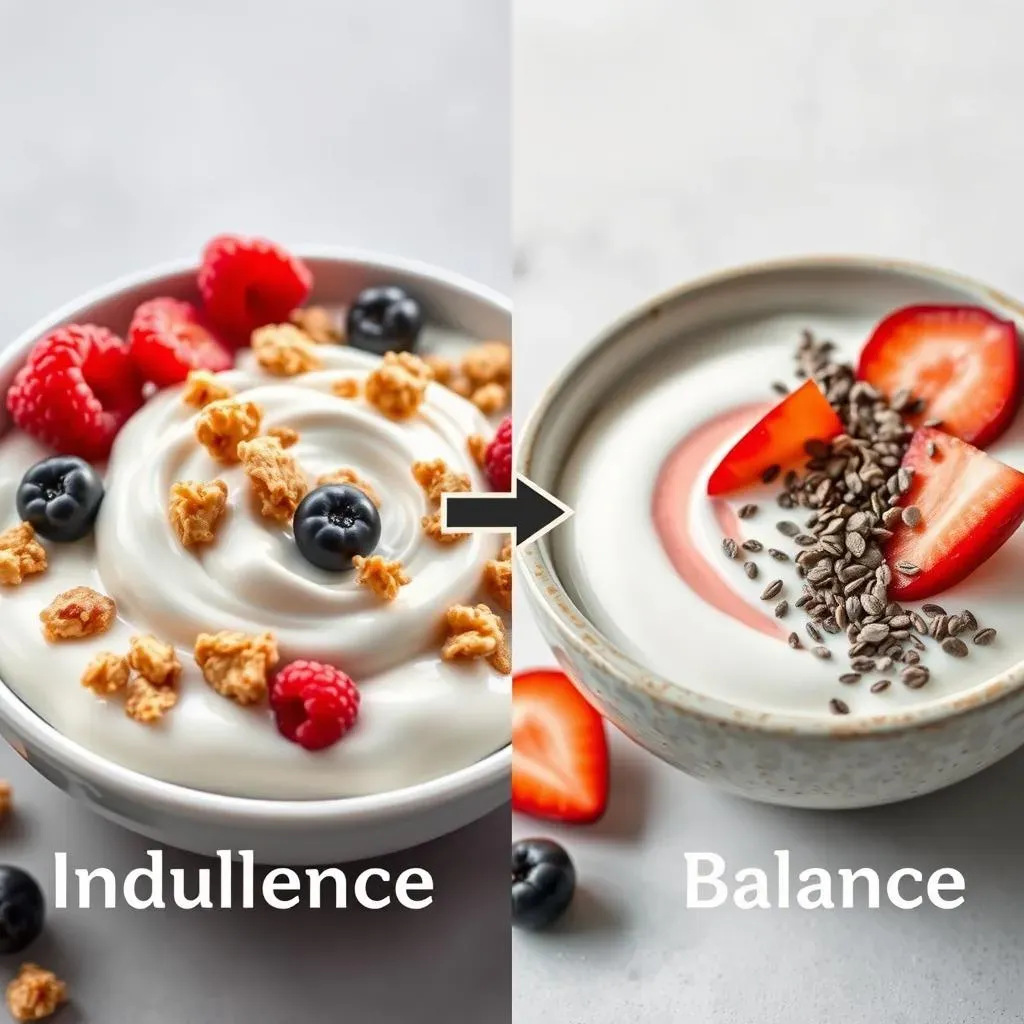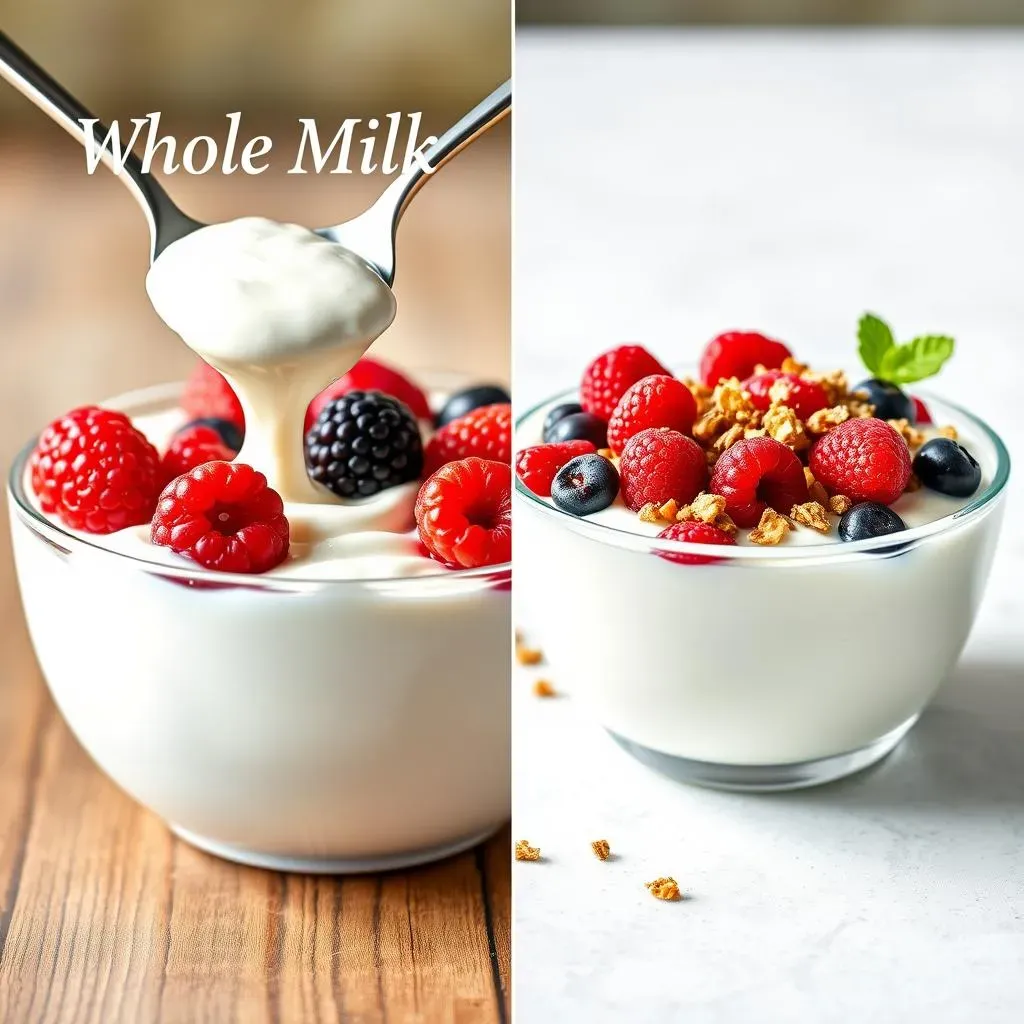Table of Contents
Navigating the dairy aisle can feel like a nutritional minefield. One of the biggest debates? Whole milk yogurt vs low fat options. For years, low-fat was touted as the healthier choice, but recent research is turning that idea on its head. Is ditching the fat truly better for you, or are we missing out on essential nutrients and benefits? This article dives deep into the world of yogurt, comparing whole milk yogurt vs low fat varieties to help you make an informed decision.
Understanding Dietary Fat: The Key to Whole Milk Yogurt vs Low Fat

Understanding Dietary Fat: The Key to Whole Milk Yogurt vs Low Fat
Let's talk fat, because when it comes to whole milk yogurt vs low fat, it's the star of the show. For years, fat got a bad rap, didn't it? We were told to avoid it like the plague, leading to a surge in low-fat and fat-free products. But here's the thing: dietary fat is essential. It's not the enemy. It plays a crucial role in hormone production, vitamin absorption, and even keeping you feeling full and satisfied. The key is understanding the different types of fat and how they impact your health. Think of it like this: not all fats are created equal.
We have saturated fats, unsaturated fats (monounsaturated and polyunsaturated), and trans fats. Dairy products, including yogurt, primarily contain saturated fat. Saturated fat has been linked to raising LDL cholesterol levels, which can increase the risk of heart disease. However, recent studies are starting to challenge this long-held belief, suggesting that the impact of saturated fat may be more nuanced than we previously thought. That's why the debate between whole milk yogurt vs low fat continues to evolve.
So, what's the takeaway? Dietary fat is important, but moderation and variety are key. When considering whole milk yogurt vs low fat, it's not just about the fat content, but also the overall nutritional profile and how it fits into your individual dietary needs.
Type of Fat | Sources | Potential Health Effects |
|---|---|---|
Saturated Fat | Dairy, red meat, coconut oil | May raise LDL cholesterol (but impact is debated) |
Monounsaturated Fat | Olive oil, avocados, nuts | Generally considered heart-healthy |
Polyunsaturated Fat | Fatty fish, flaxseeds, walnuts | Essential for brain health and reducing inflammation |
Nutritional Breakdown: Comparing Whole Milk Yogurt and Low Fat Yogurt

Nutritional Breakdown: Comparing Whole Milk Yogurt and Low Fat Yogurt
Calories, Macros, and More: The Big Picture
Alright, let's get down to the nitty-gritty. When we're talking whole milk yogurt vs low fat, the first thing most people look at is the calorie count. Generally, whole milk yogurt will have more calories than its low-fat counterpart, simply because fat contributes more calories per gram. But don't let that scare you off just yet! It's crucial to look at the whole picture, including the macronutrient breakdown: protein, carbohydrates, and fat.
Whole milk yogurt will naturally have a higher fat content, primarily saturated fat, as we discussed earlier. Low-fat yogurt, on the other hand, has had most of the fat removed. To compensate for the loss of flavor and texture, many low-fat yogurts have added sugars or artificial sweeteners. And that's where things can get a little tricky. Always compare labels carefully!
Vitamins, Minerals, and Hidden Additives
Beyond the macros, both whole milk yogurt vs low fat options offer valuable vitamins and minerals. Yogurt is a good source of calcium, potassium, and vitamin B12. However, the fat content can influence the absorption of certain vitamins. Some vitamins, like A, D, E, and K, are fat-soluble, meaning they're better absorbed when consumed with fat. So, whole milk yogurt might give you a slight edge in this department.
But here's a word of caution: many commercially produced yogurts, especially low-fat varieties, contain added sugars, artificial flavors, and thickeners. These additives can negate some of the health benefits of yogurt. Your best bet? Opt for plain, unsweetened yogurt (either whole milk or low fat) and add your own toppings, like fresh fruit, nuts, or a drizzle of honey.
Nutrient | Whole Milk Yogurt (per cup) | Low Fat Yogurt (per cup) |
|---|---|---|
Calories | Approx. 150 | Approx. 100-120 |
Fat | Approx. 8g | Approx. 0-2g |
Protein | Approx. 8g | Approx. 9-10g |
Calcium | Approx. 20% DV | Approx. 30% DV |
Health Benefits and Risks: Decoding Whole Milk Yogurt vs Low Fat

Health Benefits and Risks: Decoding Whole Milk Yogurt vs Low Fat
Gut Health and Probiotics
let's get into the good stuff! One of the biggest health benefits of yogurt, regardless of whether it's whole milk yogurt vs low fat, is its probiotic content. Probiotics are live bacteria that are super beneficial for your gut health. They help to balance your gut microbiome, which can improve digestion, boost your immune system, and even affect your mood! Yogurt is a fantastic source of these little guys, but it's important to note that not all yogurts are created equal. Look for yogurts with "live and active cultures" listed on the label to ensure you're getting a good dose of probiotics.
Now, when it comes to whole milk yogurt vs low fat, the probiotic content should be similar, assuming both yogurts are made with live and active cultures. However, some studies suggest that the fat content in whole milk yogurt might actually help to improve the absorption of certain probiotics in the gut. This is still an area of ongoing research, but it's definitely something to keep in mind. A healthy gut is linked to everything from better digestion to a stronger immune system, so feeding it the right probiotics is key!
Heart Health and Saturated Fat
Alright, let's address the elephant in the room: saturated fat. As we mentioned earlier, dairy products, including whole milk yogurt vs low fat, are a primary source of saturated fat. And for years, saturated fat has been linked to an increased risk of heart disease. However, recent research is starting to challenge this assumption. Some studies have shown that full-fat dairy consumption is not associated with an increased risk of heart disease, and in some cases, may even be protective.
So, what's going on here? Well, it's complicated. The impact of saturated fat on heart health seems to depend on a variety of factors, including the overall dietary pattern and individual genetics. Some researchers believe that the saturated fat in dairy products may have a different effect on cholesterol levels than the saturated fat found in processed foods. However, if you have a history of heart disease or high cholesterol, it's always best to talk to your doctor or a registered dietitian before making significant changes to your diet, especially when considering whole milk yogurt vs low fat options.
Health Benefit | Potential Advantage of Whole Milk Yogurt | Potential Advantage of Low Fat Yogurt |
|---|---|---|
Probiotic Absorption | Fat may enhance absorption | Similar probiotic content (if live cultures are present) |
Satiety | Higher fat content may increase fullness | Lower calorie count may be beneficial for weight management |
Fat-Soluble Vitamin Absorption | May improve absorption of vitamins A, D, E, and K | - |
Making the Right Choice: Incorporating Whole Milk Yogurt and Low Fat Yogurt into Your Diet

Making the Right Choice: Incorporating Whole Milk Yogurt and Low Fat Yogurt into Your Diet
Listen to Your Body: Tailoring Yogurt to Your Needs
so we've covered the nutritional breakdown and the potential health benefits and risks. Now, how do you actually incorporate whole milk yogurt vs low fat into your daily diet? The truth is, there's no one-size-fits-all answer. The best choice for you depends on your individual needs, preferences, and health goals. Are you trying to lose weight? Maybe low-fat yogurt is a better option, at least in terms of calorie control. Do you struggle with feeling full and satisfied? Whole milk yogurt might be more satiating, helping you to eat less overall. It's all about listening to your body and finding what works best for you.
Consider your overall diet. Are you already consuming a lot of saturated fat from other sources? If so, you might want to opt for low-fat yogurt to balance things out. On the other hand, if you're following a low-carb or ketogenic diet, whole milk yogurt can be a great way to get healthy fats and protein. And don't forget to factor in your taste preferences! If you simply prefer the taste and texture of whole milk yogurt, you're more likely to stick with it in the long run.
Creative Ways to Enjoy Yogurt: Beyond the Spoon
Yogurt is incredibly versatile! Don't limit yourself to just eating it straight from the container. There are tons of creative ways to incorporate whole milk yogurt vs low fat into your meals and snacks. Use it as a base for smoothies, add it to oatmeal or granola, or use it as a healthy topping for tacos or baked potatoes. You can even use yogurt in baking! It adds moisture and tang to cakes, muffins, and breads. Get creative and experiment with different flavors and toppings to find your favorite combinations.
For example, you can make a delicious yogurt parfait with layers of granola, berries, and a drizzle of honey. Or, try using yogurt as a marinade for chicken or fish – it tenderizes the meat and adds a subtle tang. You can also make a simple yogurt dip for vegetables by mixing it with herbs, spices, and a little lemon juice. The possibilities are endless! The main thing is to find ways to enjoy yogurt that fit into your lifestyle and make it a sustainable part of your diet.
Yogurt Use | Description |
|---|---|
Smoothie base | Add yogurt to your favorite fruits and veggies for a creamy and protein-packed smoothie. |
Oatmeal topping | Top your oatmeal with yogurt and your favorite toppings like fruit, nuts, and seeds. |
Marinade | Use yogurt as a marinade for chicken or fish to tenderize the meat and add flavor. |
Dip | Mix yogurt with herbs, spices, and lemon juice for a healthy dip for vegetables or pita bread. |
Mindful Choices: Reading Labels and Avoiding Pitfalls
Finally, a word of caution: not all yogurts are created equal. As we've mentioned before, many commercially produced yogurts, especially low-fat varieties, are loaded with added sugars, artificial flavors, and thickeners. These additives can negate many of the health benefits of yogurt. So, when you're choosing between whole milk yogurt vs low fat, always read the labels carefully. Look for plain, unsweetened yogurt with "live and active cultures" listed on the label. And be mindful of the serving size! It's easy to overeat yogurt, especially if it's flavored or sweetened.
Ideally, choose a yogurt with minimal ingredients and no added sugar. You can always add your own toppings, like fresh fruit, nuts, or a drizzle of honey, to sweeten it up naturally. Also, pay attention to the protein content. Yogurt is a great source of protein, which is essential for building and repairing tissues. Aim for yogurts with at least 8-10 grams of protein per serving. By making mindful choices and reading labels carefully, you can ensure that you're getting the most out of your yogurt and making a healthy choice for your body.
Making the Right Choice in the Whole Milk Yogurt vs Low Fat Debate
Ultimately, the choice between whole milk yogurt and low-fat yogurt depends on your individual dietary needs and preferences. There's no one-size-fits-all answer. Understanding the nutritional profiles, potential health benefits, and risks associated with each option is crucial. Prioritize a balanced diet filled with diverse whole foods, rather than fixating on a single nutrient or food group. By making informed choices and listening to your body, you can confidently navigate the dairy aisle and enjoy yogurt as part of a healthy lifestyle. Remember, moderation and mindful eating are key to long-term well-being.
